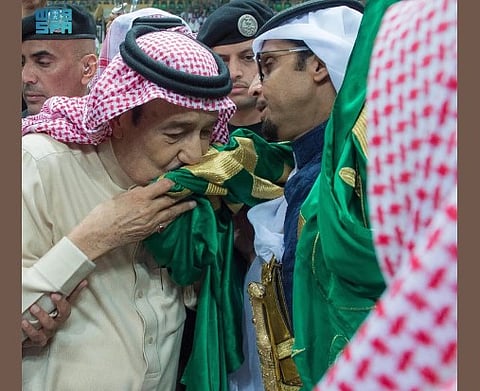

The most enduring symbol of Saudi Arabia, with its rich history dating back to its founding in 1727, is perhaps its flag. It stands as a silent witness to the unification campaigns that the Saudi state undertook three centuries ago.
The national flag, much cherished by Saudi citizens, is a powerful symbol of dignity and unity; unfurling it is a demonstration of devotion to the nation.
The flag instills pride, solidarity, love, and loyalty in the people and is a shared bond that stems from a deep sense of belonging to the country.
Beyond its national significance, the flag garners respect throughout the Islamic world. Its inscription, the Islamic creed, and its association with a state dedicated to serving Muslim communities worldwide have earned it this esteem.
The history of the Saudi national flag starts with a simple banner carried by the leaders of the first Saudi state. This early flag, crafted from green silk, bore the inscription of Shahada, the Islamic declaration of faith, "There is no God but Allah, Muhammad is the Messenger of Allah." It fluttered proudly atop a sturdy wooden post.
The flag's design remained constant until the reign of King Abdulaziz bin Abdulrahman, when two crossed swords were added, symbolizing national unification. These swords were later replaced with a single unsheathed sword positioned at the top of the flag.
Following a proposal by the Shura Council, which King Abdulaziz adopted on March 11, 1937, the sword was placed beneath the inscription of the Shahada, a design that proudly flies to this day.
A Design Steeped in Symbolism
The Saudi flag is a powerful symbol that embodies the nation's faith, history, and unity. With a law issued in 1973, the flag was designed to carry profound meanings through its colors, script, and imagery.
The flag is rectangular in shape, with green as its dominant color. This green symbolizes growth and fertility, reflecting the land's natural bounty. Against the green is the Shahada, written in white using the thuluth script.
This prominent placement underscores the nation's core religious identity. Further emphasizing this theme, a drawn sword appears parallel to the Shahada, symbolizing justice and security.
The sword's white color, just like that of the Shahada, signifies purity. The sword's placement, pointing toward the Shahada, emphasizes the idea that the Kingdom defends Islamic principles.
